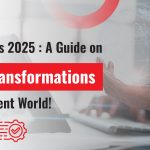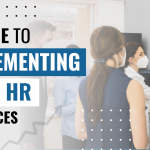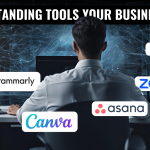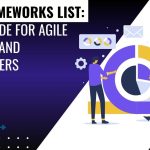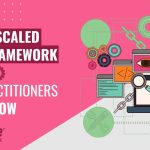Learn about the ADOPT-RISE framework for the L&D revolution with AI and Agile to scale employee efficiency.
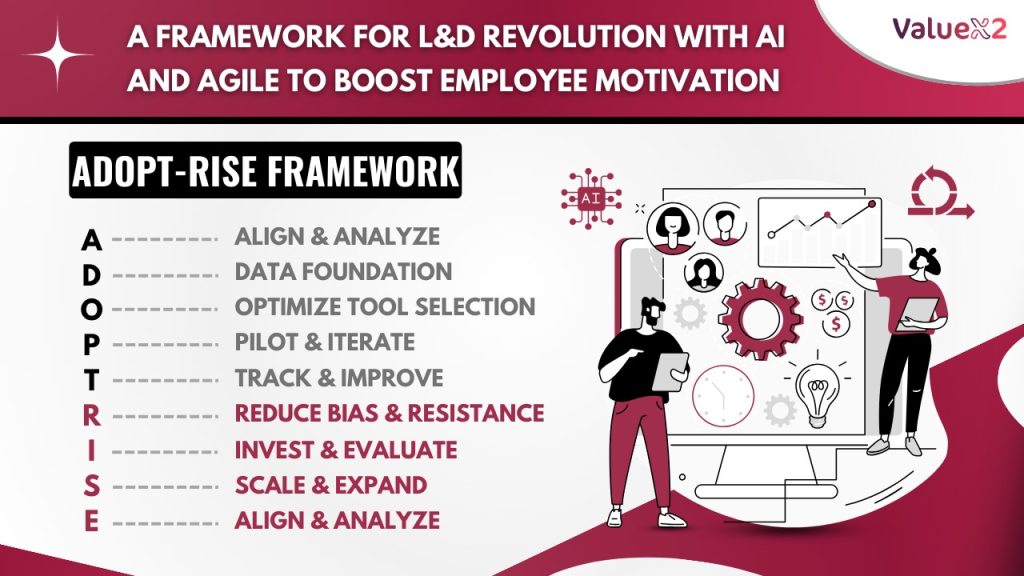
There is a growing interest in Human Resource Management on how one can leverage Agile methodology and AI technology to become a strategic people function. In this blog, we share a framework – ADOPT-RISE that Organizational Development (OD) and L&D (Learning and Development) professionals can leverage to start implementing an Agile mindset and utilize AI to make their teams efficient.
How can training and development increase employee engagement and lead to better business outcomes?
Let’s start with some interesting data to understand this topic in detail:
- Only 43% of employees say they have access to learning opportunities that can help them advance their careers.
- 60% of companies’ L&D programs have no explicit connection to the company’s strategic objectives.
The above statistics highlight some of the challenges that the training and development professionals are facing to which they seek innovative solutions within their HR strategy.
On the other hand, there is enough research to prove a positive connection between training and development, employee engagement, and positive business outcomes:
- Companies with comprehensive training programs see a 17% rise in productivity and a whopping 218% higher income per employee compared to those without
- Studies show that organizations with strong continuous learning cultures experience 30-50% higher retention rates, now that is amazing as we all know how costly hiring employees with the right skills can be!
- A staggering 92% of workers believe workplace training has a positive impact on their engagement
- Engaged employees are also less likely to be absent – Gallup reports a 41% lower absenteeism rate in highly engaged workplaces
So now the key question is how do we ensure we are giving the right learning to our employees at the right time that is having the right impact at all times?
Can AI tools and technology alongside Agile methodologies help Learning and Development Teams?
Artificial Intelligence is rapidly evolving and changing our workplace environments. New AI tools are getting launched almost every alternate day, aiming to make work and people more productive. It can be hard to keep pace!
HR Learning and Development professionals have to come up with strategies to navigate the below two challenges as they respond to the AI technology disruption and adoption curve:
- How to leverage AI tools to benefit L&D processes and professionals?; and
- How to support the ever-changing skills requirements of their employees?
What is agile learning?
Before we get into the details let us gain some clarity on the subtle differences and connections between learning culture, and agile learning.
Agile requires adapting based on feedback and failure which requires an openness to learning and experimentation. This means a Learning organization that supports continuous learning, transparency and a growth mindset is critical. This is one aspect of learning agility.
Learning agility is a personal trait that allows one to learn, unlearn and relearn.
Whereas agile learning is an approach to learning content development and instructional design that creates relevant learning experiences.
On the other hand, Agile learning draws inspiration from the agile software development methodology to create and fulfil employee training and development needs. The agile approach brings speed, flexibility, and collaboration into the traditional process.
Often, traditional Training and Development Teams focus a lot on creating the perfect learning program/content/training/course. What happens is due to this “get it all perfect” approach, the timing of the training, and its intended impact are often overlooked. If the time gap between identifying the need and delivering the training is 8 months, do you think it will have the same impact or usefulness considering how fast your businesses are moving? The reality is the businesses that HR L&D professionals support are operating in a VUCA (Volatility, Uncertainty, Complex, and Ambiguous) environment. Often the window of opportunity to make a true meaningful impact with the perfect training course that the L&D team has developed is lost due to the dynamic nature of the business.
Speed is often required to meet the needs. Agile and AI will give you support to deliver often and the most valuable product. It is not about doing things fast as much as doing the right things at the right time that help strategically achieve impact. It supports the mindset of continual growth in the organization that can be achieved by embedding Agility in L&D.
Impact of AI on employee training and development?
The use cases of AI are evolving and here are a few examples that are being used currently to enhance L&D efficiency:
- Skill-Based Personalized Learning Recommendations
- Learning Libraries and Content Generation
- Predictive Analytics to identify skill gaps
- AI-powered communities for collaborative learning
The agile methodology has often been associated with software product development that has roots in the agile manifesto for agile software development supported by its principles and values. However, these can be leveraged within the training and development as well. HR professionals across various functions have started to adopt an agile HR mindset and practices to become more employee-centric.
The ADOPT-RISE Framework uses an agile approach while implementing AI in Learning and Development (L&D)
The framework outlines a step-by-step process for integrating AI into your Learning and Development (L&D) program using an agile methodology. Here’s a breakdown of the acronym with examples for each step:
ADOPT
A – Analyze and Align
Examine the challenges you are facing in your current L&D program and see if AI can address them. Find out how AI will be used to enhance your L&D program’s future goals or current initiatives. Artificial Intelligence can be helpful in personalizing learning paths, creating and curating training materials, providing real-time feedback, and creating microlearning. This includes pinpointing the specific goals you want to achieve and the AI tools that can help you achieve those goals. There should be alignment between AI implementation and overall L&D objectives.
Example: Identify a challenge in your L&D program, such as low learner engagement with compliance training. Analyze if AI-powered personalization can address this by creating adaptive learning paths.
D – Data Foundation:
The saying “Garbage in, garbage out!” holds true for AI as well. If you feed your AI system low-quality data, you’ll get unreliable results. To avoid this, it’s necessary to assess your internal data sources before deploying any AI solutions. Clean, relevant and accurate data is the foundation of powerful AI – it’s what allows AI to make accurate predictions and uncover insightful patterns. You will need to collect and prepare data from your L&D programs, such as learner data, content data, and performance data.
Example: Gather data on learner completion rates, content interactions, and assessment scores from your Learning Management System (LMS) to identify areas for improvement. Clean and organize this data for use with AI tools.
O – Optimize Tool Selection:
There are a variety of AI tools available for L&D. Evaluate the wide spectrum of AI tools available and map them against your AI strategy and data readiness. These could be chatbots, intelligent tutoring systems, and content-authoring tools. Select the tools that align best with your needs.
Example: Evaluate various AI tools like chatbots to provide learners with personalized feedback during compliance training. Choose a tool that integrates with your LMS and aligns with the type of data you have collected.
P – Pilot & Iterate:
Avoid implementing AI across your entire L&D program all at once. HR L&D professionals should adopt an agile, incremental and iterative mindset when considering AI as an aid. As mentioned above, start with the WHY that has roots in the Business pain points, start with a pilot program and then iterate based on the results and feedback. This refinement and scaling approach will rely on collaboration with wider teams, from the very onset. This way of developing employee-centric solutions leveraging Agile Principles will be key to successful AI adoption.
Example: Develop a pilot program using the chosen chatbot for a specific department. Gather feedback from learners and iterate on the chatbot’s responses based on their experience.
T – Track & Improve:
Track the impact of AI on your L&D program and the objectives that you started with. These could include measuring metrics such as learner engagement, knowledge retention, and skill development. Ultimately the key is to collect and analyse data to measure the effectiveness of AI applications.
Example: Track metrics like learner engagement and completion rates after implementing the chatbot in the pilot program. Analyze this data to see if the tool is improving the effectiveness of your compliance training.
RISE
R – Reduce Bias & Resistance:
Implementing AI can be a big change for your organisation. System and tool challenges like potential bias in the algorithms can be addressed by conducting regular audits to detect and mitigate bias. On the other hand, human change resistance challenges can be addressed by having proactive communication of the benefits and training on AI tools. It is important to manage the change effectively to ensure that your employees are on board.
Example: Conduct regular audits to detect bias in the chatbot’s responses (e.g., favouring certain answer choices). Proactively communicate the benefits of AI-powered training to address employee concerns.
I – Invest & Evaluate:
Although AI will be used for different use cases, before scaling and expanding, evaluate the benefits both tangible and intangible. This could include comparing the costs of implementation with the improvements in learning outcomes and efficiency alongside the value-add of AI, such as increased employee engagement, quick access to upskilling and knowledge applications, and personalized learning experiences.
Example: Compare the cost of implementing the chatbot pilot with the improvement in learner engagement and completion rates. Analyze the value proposition of AI in your L&D program.
S – Scale & Expand:
Based on the success and lessons learned from the pilot, decide the scaling roadmap and approach. Keep in mind that the aspects of continuous learning from your implementation, using data to make conclusions and keeping employee needs at the heart of the AI-enabled L&D initiatives are always ongoing and should not stop after the pilot.
Example: Based on the success of the pilot, develop a plan to scale the chatbot across your entire compliance training program. Consider using the learnings from the pilot to implement AI for other L&D initiatives.
E – Ethical Implementation:
Ethical Considerations are crucial when adopting AI irrespective of the function thinking of leveraging it.
Example: Ensure user data privacy is protected when using the chatbot. Be transparent about how AI is being used in your L&D program.
AS HR L&D professionals, you don’t have to master becoming an AI prompt engineer, however, upskilling as part of becoming a T-Shaped (or even better Comb-shaped) HR professional it is always good to understand AI concepts and tools is essential.
A piece of caution and warning is that don’t consider becoming Agile and empowered by AI an overnight process. It is a journey with an emphasis placed on continuous learning and improvement. Hopefully, the step-by-step approach shared above is a practical guide to confidently navigate potential challenges and embrace AI and Agile within your L&D function.
As an HR professional, it is vital to continuously upgrade your skills and future-proof your career. Learning about Agile HR and how strategic HR management can leverage agile principles and values in the ICAgile certification course Agility in HR (ICP-AHR). These classes provide real-world takeaways, frameworks, and methods that prepare teams to apply agility to HR strategies and build their collective intelligence.
Do connect with me (Linkedin) if you want to explore this further and bounce ideas to make your L&D Agile!

Bhavna is an Agile Coach and Consultant with over a decade of experience in advisory, corporate finance, IT assurance, and operations at Big 4 and within the industry in the UK and India. She has recently been the CEO of a start-up where she implemented agile practices within HR, Marketing, and Product teams.
She is also a SAFe® Practice Consultant (SPC) and authorized instructor for ICAgile Agility in HR (ICP-AHR), Agility in Marketing (ICP-MKG), and Business Agility Foundations (ICP – BAF) training courses. She provides training for agile transformation to corporate, public, and private batches, as well as consulting for enterprise agile transformation.

